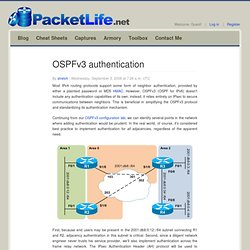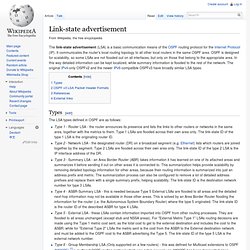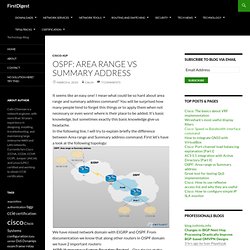

OSPF Design Guide. OSPFv3 authentication. Most IPv4 routing protocols support some form of neighbor authentication, provided by either a plaintext password or MD5 HMAC.

However, OSPFv3 (OSPF for IPv6) doesn't include any authentication capabilities of its own; instead, it relies entirely on IPsec to secure communications between neighbors. This is beneficial in simplifying the OSPFv3 protocol and standardizing its authentication mechanism. Continuing from our OSPFv3 configuration lab, we can identify several points in the network where adding authentication would be prudent. In the real world, of course, it's considered best practice to implement authentication for all adjacencies, regardless of the apparent need. First, because end users may be present in the 2001:db8:0:12::/64 subnet connecting R1 and R2, adjacency authentication in this subnet is critical. Enabling Authentication on the Interface The first parameter to specify is the Security Policy Index (SPI).
Enabling Authentication for the Area. Community String » OSPF LSA Types. Link-state advertisement. The link-state advertisement (LSA) is a basic communication means of the OSPF routing protocol for the Internet Protocol (IP).

It communicates the router's local routing topology to all other local routers in the same OSPF area. OSPF is designed for scalability, so some LSAs are not flooded out on all interfaces, but only on those that belong to the appropriate area. In this way detailed information can be kept localized, while summary information is flooded to the rest of the network. The original IPv4-only OSPFv2 and the newer IPv6-compatible OSPFv3 have broadly similar LSA types. Types[edit] The LSA types defined in OSPF are as follows: Type 1 - Router LSA - the router announces its presence and lists the links to other routers or networks in the same area, together with the metrics to them.
The opaque LSAs, types 9, 10, and 11, are designated for upgrades to OSPF for application-specific purposes. For all types of LSAs, there are 20-byte LSA headers. [edit] Type 1: Router LSA Header. EIGRP Frequently Asked Questions [IP Routing. OSPF Design Guide. OSPF: Area range vs Summary address. It seems like an easy one!

I mean what could be so hard about area range and summary address command? You will be surprised how many people tend to forget this things or to apply them when not necessary or even worst where is their place to be added. It’s basic knowledge, but sometimes exactly this basic knowledge give us headache. In the following line, I will try to explain briefly the difference between Area range and Summary address command. First let’s have a look at the following topology: We have mixed network domain with EIGRP and OSPF. You will find situation when only one physical device will be ASBR and ABR router. Why we would use this 2 commands? Let’s have a look to the routers presented in the above topology. On R1 the 2 IP subnets (192.168.1.0/24 and 192.168.2.0/24) are present in EIGRP routing protocol. On R2, there is already a basic redistribution between OSPF and EIGRP. Until now, we saw how the routers are configured. If we check now R2, we should see: Very important!